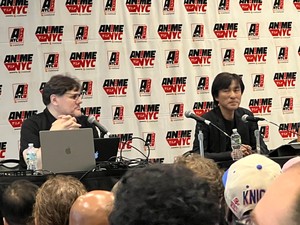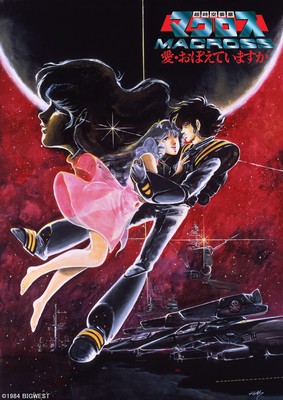All The Announcements from Anime NYC 2024
Macross: Past, Present, Future
by Bamboo Dong,
ANN's coverage of Anime NYC 2024 sponsored by Yen Press and Ize Press!

The story starts during Kawamori's school days when he was a senior in high school 47 years ago. He and his friends created an action manga set in space featuring powered suits. At the time, he—like many others—was inspired by Space Battleship Yamato and had the opportunity to visit the studio several times. “The manga was a team effort!” Kawamori says, humbly. He points to the screen, where there's an example of their manga. In the middle is a female character drawn by Haruhiko Mikimoto, who later did the character designs for Macross. “Our manga may have been the world's first powered suit manga! It came out two years before Gundam. If we weren't just a bunch of students and were able to put it out professionally, it could've been a huge sensation!”
Kawamori is quasi-joking, of course, but it's clear he's always had a knack for creativity and originality. By his sophomore year of college, he started working at Studio Nue, who did the mechanical designs for his beloved Space Battleship Yamato. After six months, they allowed him to head his first project working on the Diaclone robot toys' Car Robot subline. He led the new project, which pioneered a novel idea—cars that could turn into robots. This, of course, became the creative seed for what would eventually be known as Transformers.
After a year, he was able to work on a project that involved more mecha. Starting as a collaboration with a toy company (Takatoku Toys), he was given a single brief—“If they're not humanoid, they won't sell.” This became the genesis for Battle City Megaload/Megaroad, the original name for The Super Dimension Fortress Macross, which features the Megaroad-class colony transport ships. While Shōji Kawamori is widely considered by many to be the original creator of the Macross franchise, the initial concept was a group effort involving many of Kawamori's mentors and seniors at Studio Nue. “If they want humanoid mecha, let's make them transform! And it might as well be the biggest!” Kawamori laughs. “But I thought other people might think of the same thing. Let's put a city inside! That'll tell you how huge the scale is.” From there, they decided that a battleship wasn't enough—they didn't want people to think it was just another Yamato, so it became an aircraft carrier complete with fighter jets.
“When we went to the toy manufacturer, their feedback was that they've never sold fighter jets or aircraft carriers before. But then we said, 'The fact that you've never sold these toys before means no one has done it! So if we did it, it'd be breaking ground.'” Kawamori started studying fighter jet design, realizing that for an F-14 Tomcat, arms could be fitted between the engines. “That's what led to the Valkyrie,” Kawamori said. “We had all these sketches and 2D renderings, but the toy manufacturer kept saying, 'That won't sell.' So we built a 3D model of it. As we were building the model and playing with the joints, we realized it was approaching more and more like the original GA-WALK (GERWALK) idea we had created.” This eventually led to the iconic Valkyrie design, which could operate in three modes—a fighter jet mode, the GERWALK mode, and the upright humanoid Battroid mode. “We went back to the manufacturer and showed them the 3D model and how the three modes could be formed. The same head of the company suddenly got excited, jumped up, and started playing with it. That led to Macross.”
During the creative process of The Super Dimension Fortress Macross, the production staff pulled ideas and inspiration from everything around them. Lynn Minmay is loosely inspired by Mikimoto's sketch of a singer in Yokohama's Chinatown wearing a qi pao dress. “As soon as I saw the sketch, a lightbulb went off!” Kawamori recalled. “I realized, we can use this. Let's make her a debuting professional singer. That's how we ended up with the transforming robots, war, and a singer.”
Meanwhile, the reference artwork for rocket flare was as lo-fi as you can get. They'd started by shooting off hundreds of firecrackers in 20 seconds until would-be-mechanical animation director Ichirō Itano had a better idea—he was going to strap the firecrackers to his bicycle. “He gets me!” Kawamori laughed. He added that he had passed Itano one of his sketches for the Valkyrie, at which point Itano insisted on joining the project.
As for the key role that song plays in the series? “After ten or so episodes, I realized the story wouldn't come to a satisfactory ending in my head. It would just be a story about a super weapon. That's when I realized, the Zentradi don't know about culture. What if we ended the war with a song? All my mentors said, 'No, you can't end a war with a song.' But I said, in the real world, we're cultural and educated. It couldn't happen in our world. But this is the Zentradi! They aren't cultured. It could be possible.”

“The first thing that came to me was, what if they fight through song? But then I realized that the war is resolved through song in the original series. So I needed pilots who sing but don't fight through song, which became Basara. Because it was departing more and more from real life, I went with a manga-like approach. I realized this would be fun, but I don't think mecha fans will be thrilled about it. So that ended up becoming Macross Plus.” He brought proposals for both Macross Plus and Macross 7 to Takanashi, secretly hoping that he'd pass on both of them. “I thought, it's hard enough getting one proposal through, much less two. Maybe I can get away with not doing any Macross at all. But then he said, 'Let's do both.'” He grinned, then added, “Without Takanashi, there probably wouldn't have been any more Macross. I'm grateful to him.”
Speaking about some of his research for the franchise, Kawamori recalled the time he piloted a fighter jet. Up until that point, he had been able to ride and pilot a small Cessna, but he wanted something more acrobatic. He visited the US, where he could ride along during acrobatic flight demos. This spurred his desire for more hands-on experience, getting the chance to visit an aerial acrobatics school along with Itano, and manipulate flight controls in a practice plane during a mock dogfight. “Until then, I thought I understood air battles, but going through it blew my mind. Just by moving the stick a little bit, you end up spinning. You jerk it lightly and it does a 360.” He said the experience gave him a valuable piece of design understanding—unlike in a vehicle where the dashboard is lower in the field of sight, plane dashboards are much higher. Rather than looking forward at a road, the operator spends a lot of time looking up and behind. “A lot of times, during our mock dogfight, I was looking behind me to try and figure out where Itano was. For those who've seen Macross Plus, you'll remember there's a lot of those takes.”
He laughed and said that there was one other piece of inspiration he took away from his research trip. During their mock battle, Itano performed an “unrecommended maneuver,” causing him to black out. Itano was later asked by Kawamori to draw his real-life experience for Macross Plus in a scene where Isamu also blacks out.
Macross Zero is when CG started being incorporated into the franchise. During the Macross Plus era, Kawamori and his colleagues had been intrigued by CG, but at the time, the cost was prohibitively expensive in Japan. He and Takanashi visited an animation studio in the US (Colossus) to see how they were using CG. “I asked them why they use so much CG. And they said, 'Because it's so cheap.' I turned to Takanashi and we both said, 'Because it's so cheap??'” A bit cynically, he added, “We love to do hand-drawn animation, but in a capitalist society, we knew that eventually CG would be less expensive and used more, because there's nothing people love more than lowering the bottom dollar.” Despite his feelings about CG versus hand-drawn animation, Kawamori wanted to challenge himself, so he decided to use CG for the mecha scenes in Macross Zero; the Valkyries were still hand-drawn.
Storytime came full circle when Kawamori talked about how even more recent titles likeMacross Frontier and Macross Delta continue to heavily feature music as a theme. In a way that almost harkened back to Kawamori's quip about his high school manga preceding Gundam, he joked, “If you mention fighter jets and music, some of you may draw the parallel to Top Gun. Let me set the record straight—Top Gun came out in 1986. Macross was 1982. Do You Remember Love was 1984, which is still before Top Gun. I still don't understand why the ace pilot has a love story with his female superior. I feel like we've seen this before, no?”
He added that music has greatly added to the Macrossfranchise and has helped its longevity. He was quick to give accolades to famed composer Yōko Kanno, whom he started collaborating with since Macross Plus. He had wanted a composer with versatility, who could match the chameleon stylings of Sharon Apple, and had already worked with her on other projects like Escaflowne. Referring to Macross Frontier, “I asked if she'd be okay with working on music for an idol singer… I wanted to timidly ask if she'd be willing to do two or three songs, and she said, 'I'll do all of them!'”
As story time drew to a close, fans leaned in, hoping to learn more about the next Macross project. But unfortunately, that chapter has yet to be revealed.
“Stay tuned,” Kawamori smiled.
discuss this in the forum (2 posts) |
this article has been modified since it was originally posted; see change history
back to All The Announcements from Anime NYC 2024
Convention homepage / archives